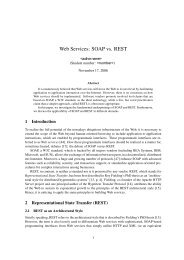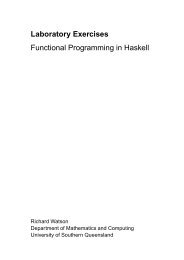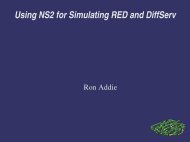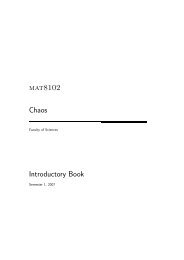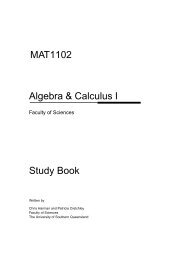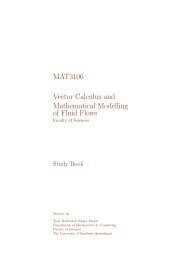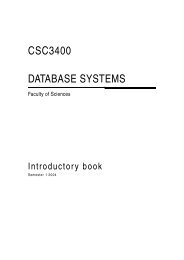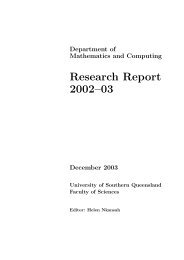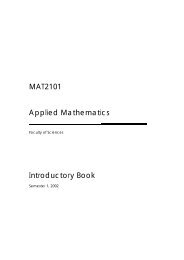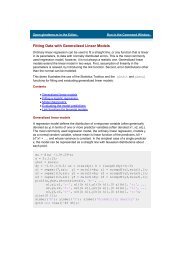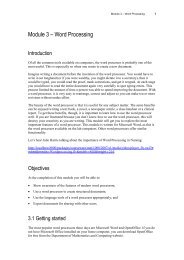Tutorial 1 – MAT1101 Solutions 1 ASCII code for plain text
Tutorial 1 – MAT1101 Solutions 1 ASCII code for plain text
Tutorial 1 – MAT1101 Solutions 1 ASCII code for plain text
Create successful ePaper yourself
Turn your PDF publications into a flip-book with our unique Google optimized e-Paper software.
<strong>Tutorial</strong> 1 <strong>–</strong> <strong>MAT1101</strong> <strong>Solutions</strong><br />
1 <strong>ASCII</strong> <strong>code</strong> <strong>for</strong> <strong>plain</strong> <strong>text</strong><br />
Shown below is a hex table <strong>for</strong> standard <strong>ASCII</strong> <strong>code</strong><br />
0 1 2 3 4 5 6 7 8 9 A B C D E F<br />
0 NUL SOH STX ETX EOT ENQ ACK BEL BS TAB LF VT FF CR SO SI<br />
1 DLE DC1 DC2 DC3 DC4 NAK SYN ETB CAN EM SUB ESC FS GS RS US<br />
2 ! " # $ % &<br />
′<br />
( ) * + , - . /<br />
3 0 1 2 3 4 5 6 7 8 9 : ; < = > ?<br />
4 @ A B C D E F G H I J K L M N O<br />
5 P Q R S T U V W X Y Z [ \ ] ∧<br />
6 ‘ a b c d e f g h i j k l m n o<br />
7 p q r s t u v w x y z { | } ∼ DEL<br />
The row number is the sixteens digit and the column number the units digit.<br />
(a) If your name was the character string ’SPUNDE’ then the hex equivalents <strong>for</strong> each character<br />
read from the table are: 53 50 55 4E 44 45<br />
Convert each hexadecimal number to binary:<br />
0101 0011 0101 0000 0101 0101 0100 1110 0100 0100 0100 0101<br />
You can leave the spaces or not (<strong>for</strong> readability) but the string of ”lights” in the computer is<br />
represented in <strong>ASCII</strong> <strong>code</strong> by the bit string:<br />
010100110101000001010101010011100100010001000101<br />
De<strong>code</strong><br />
010101110110000101101100011101000110010101110010<br />
Break the bit list into blocks of 8 and each block into two blocks of 4:<br />
0101 0111 0110 0001 0110 1100 0111 0100 0110 0101 0111 0010<br />
Convert each block into a hexadecimal number, each bundle of 4 being one place value in<br />
hex:<br />
5 7 6 1 6 C 7 4 6 5 7 2<br />
Now read the symbol from the conversion table:<br />
W a l t e r<br />
You can exchange messages with others in this course but the amusing thing is that the<br />
messages you send one another will be transmitted in <strong>ASCII</strong> <strong>code</strong> (or some super-set of it).<br />
It is very convenient to have functions (in Matlab or J or functions in other software) to<br />
do the encoding and decoding. Maybe they are already available (?). Actually, in Matlab,<br />
the functions char and double will do the conversions but only from and to the decimal<br />
equivalents of the <strong>ASCII</strong> <strong>code</strong>s.<br />
char([87 97 108 116 101 114])<br />
ans =<br />
Walter<br />
double(’Walter’)<br />
ans =<br />
87 97 108 116 101 114
In J the supplied constant a. gives the list of (extended) <strong>ASCII</strong> symbols and locating where<br />
a symbol is in this list will give the decimal equivalent to the <strong>ASCII</strong> <strong>code</strong>.<br />
In Matlab the functions dec2hex and dec2bin will convert decimals to hex and binary respectively<br />
and the functions hex2dec and bin2dec will per<strong>for</strong>m the inverse operations.<br />
In Matlab the command<br />
bits= dec2bin(double(’Walter’)); reshape(bits’,1,prod(size(bits)))<br />
will produce the <strong>ASCII</strong> <strong>code</strong> <strong>for</strong> ’Walter’.<br />
Similar functions can be written in J and will be defined if you run the script conversions.ijs<br />
(available from the website) in J.<br />
2 Binary and hexadecimal representation of numbers<br />
(a) Convert the binary numerals 11000101 and 10000101010 to hexadecimal numerals<br />
and hence to decimals.<br />
110001012 = (1100)(0101)2 = C516 100001010102 = (0100)(0010)(1010)2 = 42A16<br />
C516 = 12 × 16 + 5 = 197 42A16 = 4 × 256 + 2 × 16 + 10 = 1066<br />
(b) Convert the binary numbers 10111.101 and 0.0010101 to decimals.<br />
10111.101 is 2 4 + 2 2 + 2 + 1 + 2 −1 + 2 −3 = 16 + 7 + 0.5 + 0.125 = 23.625<br />
0.0010101 is 1<br />
8<br />
+ 1<br />
32<br />
+ 1<br />
128<br />
= 21<br />
128<br />
= 0.1640625<br />
(c) Convert the decimal numeral 2008 to a binary one and hence to a hexadecimal<br />
one.<br />
The powers of 2 are tabulated below<br />
n 0 1 2 3 4 5 6 7 8 9 10 11 12 13 14<br />
2 n 1 2 4 8 16 32 64 128 256 512 1024 2048 4096 8192 16384<br />
By subtracting 1024 from 2008 we are left with 984, which is 512+472. Continuing on in this<br />
way, we see that<br />
2008 = 1024+512+256+128+64+0+16+8+0+0+0<br />
= 2 10 + 2 9 + 2 8 + 2 7 + 2 6 + 0 + 2 4 + 2 3 + 0 + 0 + 0.<br />
so that in a binary numeral system 2008 is represented by 11111011000.<br />
Grouping in bundles of 16, we have<br />
2008 = (2 2 + 2 1 + 2 0 )2 8 + (2 3 + 2 2 + 2 0 )2 4 + (2 3 )<br />
2008 = (4 + 2 + 1)16 2 + (8 + 4 + 1)16 + (8)<br />
so, in hex, 2008 is 7D8, which you could also have easily read from (0111)(1101)(1000).<br />
Convert decimal 1943 to hexadecimal first and hence write down its binary representation.<br />
The powers of 16 are tabulated below<br />
n 0 1 2 3 4 5 6<br />
16 n 1 16 256 4096 65536 1048576 16777216<br />
from which we can deduce that 1943 = 7(16 2 ) + 151 = 7(16 2 ) + 9(16) + 7 so that the hex<br />
numeral <strong>for</strong> 1943 is 797. Its binary representation is there<strong>for</strong>e 011110010111.<br />
(d) Write the <strong>ASCII</strong> <strong>code</strong> <strong>for</strong>: 2008<br />
From the <strong>ASCII</strong> table we get: 00110010001100000011000000111000.



